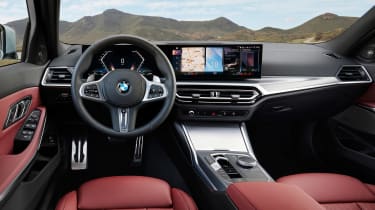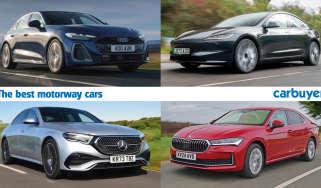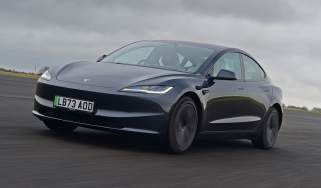2023 BMW 3 Series facelift brings all the tech
Mid-life update for BMW’s top-selling executive car brings sharper looks and a new infotainment, but no EV model
- Refreshed styling
- 'Curved Display' infotainment system
- On sale now from £36,670
The BMW 3 Series has always been the gold standard for compact executive cars, yet it has recently begun to feel outdated against newer rivals like the latest Mercedes C-Class. BMW seeks to remedy this, however, with a new mid-life update for the top-selling model that includes a sharper exterior facelift and a heap of cutting-edge interior tech.
 Top 10 best motorway cars 2025
Top 10 best motorway cars 2025
The updated model of the 3 Series is available to order now, with prices starting at £36,670 – nearly £3,500 more than the outgoing car. Just like before, buyers will be able to choose from a sporty saloon or a practical estate bodystyle. While SUVs are continuing to steal market share away from the compact executive car space, the 3 Series is still a very important model for BMW and it can’t rest its laurels in a fiercely competitive segment, alongside the likes of the Audi A4, the Genesis G70, and the aforementioned C-Class.
2023 BMW 3 Series: design
To the untrained eye, not much has changed for this latest rendition of the 3 Series; however, look closer and you’ll see that BMW has made some minor exterior changes to keep the car looking fresh. Perhaps the most noticeable change is the new set of LED headlights – these are slimmer than before and almost appear like the old set have been flipped upside down. These new units flank a redesigned kidney grille which, unlike some recent BMW models, has not been significantly enlarged for this facelift. Instead, the whole design has been made to appear more angular, similar to the one fitted to the facelifted BMW 5 Series.
BMW has also tweaked the front and rear bumpers, taking inspiration from the high-performance M3 and M4 models. Buyers can specify alloy wheels ranging from 17-19 inches in size and there are also four new paint colours to choose from: three metallic greys and an all-new blue shade.
As before, those looking to enhance the sportiness of their new 3 Series can select the optional M Sport Pro pack. This swaps the exterior chrome detailing for more aggressive gloss black trim, while also adding red brake calipers and a subtle boot spoiler.
Interior and technology
The most radical changes for the new BMW 3 Series have taken place on the inside, as the facelifted model gets the brand’s latest tech. Stepping into the cabin, your eyes will immediately be drawn to the new ‘Curved Display’ infotainment setup that debuted on the electric BMW iX SUV. This consists of a ‘floating’ 12.3-inch digital instrument cluster, alongside a 14.9-inch central touchscreen, both running BMW’s latest iDrive 8 software.
Elsewhere, changes have been made to accommodate the new infotainment setup. There are no climate controls on the centre of the dashboard, as these have now been relegated to the bottom of the infotainment screen – something that may come as a frustration to many, as this type of control is typically more difficult to use when out on the road. Instead of a traditional automatic gear selector, BMW has replaced this with a more minimalist toggle switch. All cars get sporty paddle shifters mounted on the back of the steering wheel, which allow you to manually change gears as if in a Formula 1 car, while an automatically dimming rear-view mirror is also now standard.
Engines and powertrains
BMW has revamped the 3 Series’s engine range for its mid-life update. As before, there is a selection of petrol and diesel engines as well as a company car tax-busting plug-in hybrid model. As of 2020, the diesel models have benefited from 48-volt mild hybrid power for extra efficiency – however the facelift has not introduced a fully-electric variant, as this niche is already filled by the BMW i4.
Kicking off the updated range is the petrol-powered 320i which starts from £36,670, with xDrive four-wheel-drive costing an extra £1,550. This model uses a 2.0-litre turbocharged four-cylinder engine with 181bhp and, like all 3 Series models, is paired with an eight-speed dual-clutch automatic gearbox.
Next in the range is the more powerful 330i which uses the same 2.0-litre unit as the 320i, but this time with a redesigned exhaust manifold and turbocharger. This gives the 330i an output of 254bhp and allows the saloon to cover the 0-62mph sprint in 5.9 seconds, with the estate taking just 0.1 seconds longer. Prices for the 330i start from £40,740.
BMW has reduced the 3 Series diesel lineup to just one model – the top-selling 2.0-litre, four-cylinder 320d. As previously mentioned, this now utilises mild-hybrid assistance and produces 187bhp during everyday driving, with a short boost of 11bhp available from the car’s electric motor. However, the greatest benefit of the mild-hybrid powertrain is the increase in fuel economy; BMW claims the 320d can return up to 58.9mpg. Rear-wheel-drive models start from £39,515, with xDrive cars pushing the price up to £41,065.
The BMW 330e plug-in hybrid remains entirely unchanged and now starts from £42,610. This uses a four-cylinder petrol engine, alongside an electric motor to produce 288bhp and boasts a pure-electric range of around 35 miles. High MPG figures and low CO2 emissions of just 30g/km make this the best choice for company car drivers looking to avoid high Benefit in-Kind bills.
Topping the 3 Series range are the M-badged M340i and M340d models which both start from £52,965. As before, the M340i uses a turbocharged six-cylinder engine with 369bhp and can reach 62mph from a standstill in just 4.4 seconds. Like the entry-level 320d, the M340d gets mild-hybrid assistance, but instead produces 335bhp from its six-cylinder unit. The high-performance M3 and M4 models are likely to be facelifted soon as well, along with the much-anticipated M3 Touring estate.
What does this mean for car buyers?
The aim of a facelift is typically to bring an ageing car back into the spotlight, and this update for the 3 Series is no different. Although the changes seem minor on paper, the added tech and sleeker looks go a long way to modernising the nearly four-year-old seventh-generation 3 Series. BMW has removed the old entry-level 318i model, resulting in a higher starting price – however, the 320i still comes in cheaper than a base example of the Mercedes C-Class, which starts from around £40,000. Regardless, most people looking at a new 3 Series will be company- car buyers and while the 330e does seem appealing, the hybrid C-Class still offers almost double the electric range.
Want to keep those BiK bills as low as possible? Check out our list of the Top 10 best company cars
Recommended
Most Popular
Tips & advice

Car dashboard warning lights: what does each symbol mean?

Electric car charging stations: public networks, charger types, apps and maps
















